Anwesh Satpathy's Blog, page 2
June 24, 2020
Free during Speech,not After

The case of 19-year-old Amulya Leona as well as that of Safoora Zargar has reignited the debate on the right to dissent and freedom of speech in India. Leona was arrested under sedition simply for raising slogans while Zargar was arrested, without ample evidence, for inciting riots. Moreover, the Delhi police recently filed another baseless charge-sheet against the activist Harsh Mander for inciting riots. Before talking about the current scenario, it is important that we look at this issue from a historical perspective.
The many mistakes of Congress
Members from the current ruling regime in India have now cultivated a habit of blaming the opposition, i.e. the Indian National Congress, for their own incompetence and failures. They never get tired of blaming Nehru. I personally consider this to be unproductive most of the times. In matters of free speech, however, the blame lies solely with the immediate ruling establishment in the aftermath of Independence.
For a brief period immediately after independence, freedom of speech was almost absolute in India. In 1949, Shaila Bala Devi called for a revolution in India through her Bengali leaflet “Sangram”. The government of Bihar asked her to deposit a security amount. Shaila Bala refused and took the case to Patna High Court. The court, while ruling in her favour, added that “‘if a person were to go on inciting murder or other cognizable offences either through the press or by word of mouth, he would be free to do so with impunity”. These lines were written by Justice Sarjoo Prasad.
The first amendment was watered down immediately after this incident. The original Article 19 read as follows: -
“ (1) All citizens shall have the right — (a) to freedom of speech and expression;
(2) Nothing in sub-clause (a) of clause (1) shall affect the operation of any existing law in so far as it relates to, or prevent the State from making any law relating to, libel, slander, defamation, contempt of court or any matter which offends against decency or morality or which undermines the security of, or tends to overthrow, the State.”
In 1950, the state of Madras banned the “entry and circulation” of the Marxist Romesh Thapar’s English magazine “Cross Roads”. The Madras Maintenance of Public Order allowed the govt to censor newspapers which it deemed to be a threat to “public safety/order”. Mr. Thapar challenged the ban in the Supreme Court. While declaring the provision to be unconstitutional, the court held that freedom of speech can only be curtailed when the foundations of state are endangered or when the speech in question directly threatens to overthrow the state. The court further added that “very narrow and stringent limits have been set to permissible legislative abridgement of the right of free speech and expression”
The same reasoning was applied in the Brij Bhusan V. State of Delhi. In this case, the govt asked the RSS affiliated magazine “The Organizer” to submit all materials it sought to publish on Pakistan for scrutiny before publication. The provision was discarded by the court citing the Romesh Thapar case.
These judgements seem to have perturbed the then-ruling establishment. Thus, the government decided to amend the first amendment. In “statement of objects and reasons”, the govt specifically referenced Justice Sarjoo Prasad’s words “The citizen’s right to freedom of speech and expression guaranteed by article 19(1)(a) has been held by some courts to be so comprehensive as not to render a person culpable even if he advocates murder and other crimes of violence.”
Thus Article 19(2)’s wordings were changed: -
“(2) Nothing in sub-clause (a) of clause (1) shall affect the
operation of any existing law, or prevent the State from making any
law, in so far as such law imposes reasonable restrictions on the
exercise of the right conferred by the said sub-clause in the
interests of the security of the State, friendly relations with
foreign States, public order, decency or morality, or in relation to
contempt of court, defamation or incitement to an offence.”
It is worth mentioning here that though the Bill was primarily bought in by Jawaharlal Nehru, it was supported by the likes of Vallabhai Patel,C Rajagopalachari and BR Ambedkar. The prominent voice opposing the bill was Shyama Prasad Mookerjee. While he was arguing against the bill, some members roared “Ask the High Courts. A person can preach murder and still go scot-free”
 Shyama Prasad Mookerjee with Jawaharlal Nehru
Shyama Prasad Mookerjee with Jawaharlal NehruWhile arguing against the first amendment, Mookerjee asked whether criticisms of foreign countries is prohibited under the pretext of maintaining “friendly relations with foreign states”. Specifically referring to Pakistan, he asked “If I hold that this partition has been a mistake and has to be annulled some day or the other, why should I not have the right to agitate for it?”. The fact that his concerns were valid was proved when Pandit Krishna Chandra Sharma responded by stating “to rise in revolt against Pakistan is to rise in revolt against the Constitution itself.”
Mookerjee’s objection turned out to be prophetic. In 2014, a documentary on Sri Lankan Civil War which details the extrajudicial killings of Tamils, failed to receive a certificate from the Central Board of Film Certification. The Board argued that it will strain “friendly relations” between the two countries.
Moreover, the Unlawful Activities (Prevention) Act passed during Indira Gandhi’s regime broadened the scope of what can and cannot be said. According to this act, any claim which “questions, disrupts or is intended to disrupt the sovereignty and territorial integrity of India’” is “unlawful”. The words “sovereignty and integrity” were also added to Article 19(2) during the Sixteenth Amendment. It seems perfectly reasonable to ask whether advocating for the reunification of India and Pakistan harms the “territorial integrity of India” or “friendly relations with foreign states”. Why should this be treated as sacrosanct?
These laws were used to justify the suppression of dissent. For instance, Nehru’s regime jailed the Leftist Urdu poet Majrooh Sultanpuri for writing a poem which compared Nehru with Hitler. Sultanpuri refused to apologize and spent two years in jail.
Nehru’s regime also used the CBFC to censor songs and movies. These songs weren’t too radical by any stretch of the imagination. They were merely expressions of disenchantment with the ruling establishment. Consider, for instance, the following lines from a censored song of the 1961 movie “Amar Rahe Ye Pyaar”: -
“God is in the heavens while we are here on earth These days,
He does not pay us much attention
Who can He send here to sift through these sands,
To figure out the condition of these teeming masses?
For there are too many people,not enough deities”
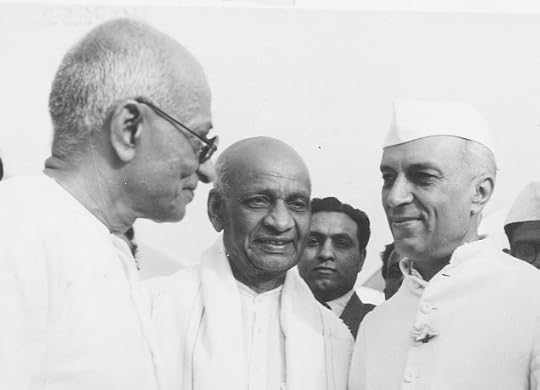 C Rajagopalachari, Patel&Nehru
C Rajagopalachari, Patel&NehruIndependent India had no institution to control the production of movies before 1952. Few months after independence, C Rajagopalachari wrote a letter to Home Minister Sardar Vallabhai Patel expressing his concern for a movie being prepared on the freedom movement. Rajagopalachari was afraid that it’ll serve as a “romantic attraction of crime for semi-educated people”. In his reply, Patel stated that the government had no control over movies while advising Rajagopalachari to “hint” that the movie is not ready for public exhibition. Against this backdrop, the Cinematograph Act of 1952 was introduced . Thus, the CBFC (popularly and unironically referred to as the “Censor Board”) was formed.
Sedition
One of the most peculiar aspects of the Constituent Assembly was the fact it retained the law of sedition. The likes of Gandhi, Tilak and Nehru were convicted and arrested for sedition. Yet, sedition was included as a reasonable restriction to the freedom of speech. Though Nehru did refer to sedition law as “highly objectionable and obnoxious” which needed to be discarded, his regime did nothing of the sort.
Nevertheless, in 1950, the Punjab High Court scrapped sedition stating “It is enough if one instance appears of the possible application of the section to curtailment of the freedom of speech and expression in a manner not permitted by the constitution. The section then must be held to have become void.”
The Supreme Court, however, disagreed. In 1962, Kedar Nath Singh was charged under sedition for uttering these words: -
“The people of India drove out the Britishers from this country and elected these Congress goondas to the gaddi and seated them on it. To-day these Congress goondas are sitting on the gaddi due to mistake of the people. When we drove out the Britishers, we shall strike and turn out these Congress goondas as well. These official dogs will also be liquidated along with these Congress goondas. These Congress goondas are banking upon the American dollars and imposing various kinds of taxes on the people to-day. The blood of our brothers- mazdoors and Kishanas is being sucked. The capitalists and the zamindars of this country help these Congress goondas. These zamindars and capitalists will also have to be brought before the peoples court along with these Congress goondas.”
The Supreme Court convicted Kedar Nath Singh and upheld the constitutionality of sedition.
The sedition law actually became stricter in independent India. It was only during Indira Gandhi’s regime that sedition was made a cognizable offence (i.e. one can be arrested without warrant).
The exact definition has often been broadened. In 1995, the Supreme Court hinted that mere utterance of words cannot be held as sedition. While ruling on individuals who chanted separatist slogans, the hon’ble court made it clear that sedition can only be applied when the written/spoken word causes “disturbance or semblance of disturbance of law and order or of public order or peace and tranquility”.
Subsequent regimes have used sedition to suppress dissent. The UPA regime used the law against writer-activist Arundhati Roy for supporting separatist causes. Sedition charges were slapped against an entire village for protesting nuclear plant. The present regime has also used it against JNU students and most recently in the case of Amulya Leona.
Hate Speech
Despite being a self-proclaimed secular democracy, India has a blasphemy law in the form of Sec 295A. This section forbids speech which insults religious feelings. Accompanying this is section 153A which restricts speech that promotes enmity between different groups.
In 1920s, a short book titled Rangila Rasul criticizing Prophet Muhammad was published. Unsurprisingly, this book angered Muslims. Situations became more strained when the Punjab High Court found the publisher to be “not guilty” under Sex 153A. It reasoned that insult to the Prophet is not the same as insult to the community. Under these circumstances, the British were forced to introduce Sec 295A.
Both of these laws make it extremely easy to restrict speech. Thus, it has been used to arrest people for making mild criticisms against politicians. In 2018, two individuals were booked under this section for mocking the PM.
This section has also been used to restrict movies, books and music. Many individuals have been arrested simply for criticizing and mocking religion or religious figures.
In 2018, the defence analyst Abhijit Iyer-Mitra was jailed for making a joke online that apparently hurt the religious sentiments of people.While denying him bail, the then Chief Justice Ranjan Gogoi remarked “the safest place for you would be in jail”.
The Way Out
The opposition nowadays portrays itself as an advocate of freedom of speech. This is ironic considering the fact that the Congress had no problem with these restrictive laws when it was in power. As we have seen, the Congress made good use of these laws. This is mere rhetoric. Neither the Congress nor the BJP wants a systematic change. These laws are actually extremely useful for them to suppress legitimate criticism.
Freedom of Speech in India currently doesn’t include the right to offend. According to the Maharashtra High Court, even truth is not a sufficient defence against 295A . You are required to express your opinions in a manner which doesn’t hurt the sentiments of others. The problem is that it’s not possible. The moment you express your opinions, you are bound to hurt the sentiments of some people. Why should the religious sentiments of individuals prevail over my right to speak?
Those supporting the restrictions often argue, as the likes of Rajagopalachari did, that we are a country with a semi literate population. Our people are highly religious. They will resort to violence when their religious sentiments are hurt. I find this argument to be 1) insulting to the people of India,mildly perpetuating the colonial “primitive savages” rhetoric and 2) an admission by the establishment that it can’t maintain law and order. Doesn’t the current ruling regime love to remind us that we are a tolerant country? How can we be tolerant when there are legal ways to restrict harmless speech? Why is the establishment bowing down to the violent mob? Why is “The Satanic Verses” still banned?
Freedom of speech loses its meaning if it doesn’t include the right to offend, mock and insult. It is scary that we live in a country where one can be arrested simply for raising slogans. The state must protect our speech against the mob, not the mob from our speech. While speaking against the dilution of free speech, Somnath Lehri of the constituent assembly rhetorically asked (referring to sedition): — “Does Sardar Patel want even more powers than the British Government an alien Government, an autocratic Government which is against the people — needs to protect itself?”. The same can be asked to the present ruling establishment. One can only hope that the BJP fulfills the dreams of its guiding light Shyama Prasad Mookerjee by undoing the damage done to India’s free speech laws.

June 1, 2020
“Dear Mr. PM”: A 17 year old writes to the Prime Minister

Dear Mr. Prime Minister,
I came across your letter to citizens of India(30/5/20)recently on your website. As you rightfully point out, your electoral win was indeed historic. The people of India trust you. Along with many citizens of this country, I’m proud to live in a country which has the democratic institutions that make it possible for a “chaiwalla”(tea-seller) to become PM.
However, my tone throughout this letter will be respectful but critical. Some would call this “the beauty of democracy”. The hon’ble Supreme Court has referred to dissent as the “safety valve of democracy”. Dissent is indeed a wonderful thing but I don’t think people should be obligated to the establishment for providing them with rights that they deserve.
Even before your first term,a cult of personality was formed around you. This only strengthened with time. We were told , among other things, that you were “Vishnu’s avatar”, “God’s gift to the nation”, the world’s most beautiful face and a great economist. These were eminent members of your party. Many of them are Ministers. The fact that this rhetoric continued leads one to assume that you revel in sycophancy.
In 2016,you announced your plan to clean Ganga. According to official sources, Ganga was supposed to be clean by July 2018. This was not merely an environmental issue, it was a symbolic statement as well. The river Ganges is a holy river for Hindus so one naturally assumes that it’d be your priority considering your adherence to Hindutva. 2018 came and went. Ganga did not become clean. A Hindu sannyasi and a former environmental engineering Professor G.D. Agrawal wrote a letter to your government complaining about the lack of action. The 86 year old Professor went on a fast unto death and elucidated his demands in a letter. The government failed to respond appropriately and the Sadhu died on 111th day of the fast from starvation. Along with many other conscientious citizens, I continue to believe that it was a murder.
It would be futile to expect you to take any concrete action on environmental issues and climate change considering the fact that you believe “climate has not changed” only people have changed.
We have also witnessed a slow capture of independent institutions. Many of your present day critics, such as the journalist Tavleen Singh, hoped that you’d dismantle influence of the elite Lutyen’s Delhi Durbar. You were seen as an outsider. One who won’t bow down to the influence of few courtiers. This elite circle was rightly referred to as exclusionary since it focused only on Delhi. This is not what has happened. We continue to passingly hear taunts at Lutyen’s Delhi. Indeed, you have mentioned it yourself. But there has been no systematic change at all. Lutyen’s Delhi continues to act as a propaganda tool for the establishment. The media now openly propagates polarization. It asks questions to the opposition, but rarely to the establishment. You have encouraged this attitude by giving interviews only to News outlets which praise you. They ask you about your poems, your childhood, your navratri fasts, your tireless energy, your selflessness, your “fakiri”, your apparently unscripted interviews abroad,your fashion sense, the medicines you take while ill, the movies you watch, the songs you listen to, how you eat mangoes and your sleep schedule. You have time to do an hour long interview with a Canadian Bollywood actor but you don’t have time to do a press conference. You don’t have time to do interviews with those who criticize you. You treat media outlets merely as a means to an end. A means to get your message, your propaganda across.
Your regime is also slowly capturing the judiciary. Recently, the Gujurat High Court claimed that those who cannot “do anything good for the people have no right to criticize the functioning of the state government.” I consider this to be a rather petulant observation. The citizens of this country have every right to criticize and hold the government accountable. The government works for the people. Your government nominated former CJI Ranjan Gogoi as a Rajya Sabha MP just months after his retirement. This was seen by many as a clear Quid pro quo. Many of Justice Gogoi’s judgement continue to be mired in controversy. His dilution of free speech, his open defense of Assam NRC while the matter was still sub judice and his utter shamelessness in constituting a special bench to preside over a sexual harassment allegation against himself. One cannot help but wonder whether the nomination was a “reward” to him for delivering verdicts that worked in favor of your regime. Your late friend Mr. Arun Jaitley was spot on when he said “Pre-retirement judgements are influenced by post-retirement jobs.”
In your letter, you mentioned the Ram Mandir judgement of the Supreme Court along with achievements of your government. One wonders why you didn’t feel the need to write a letter(or even a tweet) hailing the Supreme Court’s equally historic judgement on Sec 377 and the Sabarimala issue. In fact, you seem to have actively opposed the Sabarimala judgement while remaining ambivalent about LGBTQ issues. Your government’s neutral approach to Section 377 was excoriated by Justice DY Chandrachud himself. Justice Chandrachud rightfully points out that this section treated LGBTQ individuals on par with rapists and child molesters. Thus, the government’s neutral stance does nothing to prevent the “stigmatization” of the LGBTQ+ community. Could this be due to the fact that the Ayodhya judgement was politically expedient for you?
While you were holding a highly publicized event with President Trump in February, Delhi was burning. President Trump praised you for “working very hard on religious freedom” while citizens were being slaughtered for belonging to a different religion. The police openly took sides and chanted “Jai Shree Ram” while charging at Muslim protesters. For your critics, this wasn’t surprising. The country witnessed the same lack of law and order bordering on state complicity during the Gujurat riots . One can attribute this to incompetence but the fact that there’s a pattern makes me wonder whether its sheer calculated malevolence.
The lack of proper planning of lockdown has added to the unnecessary misery of migrants and day laborers. We have come across harrowing visuals of injured migrants who were forced to travel with dead bodies in the back of a truck, migrants dying of starvation and most recently the video clip of a baby trying to wake up of its mother who died of starvation. The fact that this has continued for almost a month now speaks volumes about the ineptness of the establishment.
You talk about the pluralism of the nation while considering MS Golwalkar to be “Pujniya”(worthy of worship). In his book, We or Our Nationhood defined, Golwalkar writes “The foreign races in Hindustan must either adopt the Hindu culture and language, must learn to respect and hold in reverence Hindu religion, must entertain no ideas but those of glorification of the Hindu race and culture or may stay in the country wholly subordinated to the Hindu nation claiming nothing, deserving no privileges, far less any preferential treatment not even citizens rights.’’
You claim that the Constitution is your holy book while idolizing Deen Dayal Upadhyaya, who condemned the constitution and the use of the word “secular”(along with Golwalkar).
You claim to stand for the ideals of Gandhi but take no action against Sadhvi Pragya for referring to his murderer as a “patriot”. You claim to believe that “the entire world is one family” while choosing the communal Yogi Adityanath as CM of UP. Mr. Adityanath has openly instigated violence and claimed that Hindus and Muslims cannot co-exist.
Your followers claim that opposition to you is opposition to the country. They have created an “us Vs. Them” narrative. The fact remains that you are not the country. The BJP doesn’t have a monopoly on nationalism, despite what the media would want us to believe. India is a democracy and you have only been elected to serve the people. You are accountable to the people. The people have elected you and they have every right to criticize you if they’re dissatisfied. Some would blame me for criticizing you for what MPs and Ministers of your party say. Surely, you’re not responsible. However, your silence has fostered this polarization. The buck stops with you.
Your ambivalence, your silence and your neutrality is a statement in itself. Mr. Prime Minister, speak up. Never before has silence screamed so loud. Speak up lest you go down in history as the real “Silent Prime Minister.”
Yours respectfully,
Anwesh

May 21, 2020
The trouble with Identity politics
A specter is haunting the world. The specter of identity politics.
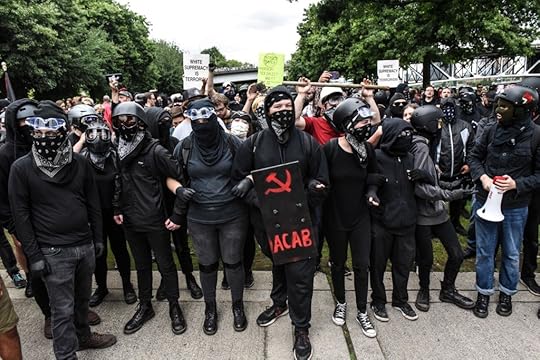
In 2017, a group of Neo Nazis and white supremacists gathered in the small town of Charlottesville under the pretense of protecting confederate heritage. For them, the removal of monuments dedicated to racist slaveholders was an attack on American history itself. There were no KKK hoods this time. They didn’t hide their identity. The rise of right wing populism in the US was seen as a win for their ilk, their people. White people. The rally ended in violence as a white nationalist ideologue rammed his car over a group of anti racist protesters. This led to the death of a 32 year old Heather Heyer.
There have been multiple Neo Nazi rallies in Europe in the past few decades. However, these have been rare and have mostly escaped media coverage. “Unite the Right” rally, on the other hand, received international attention. The so-called “Alt Right” was at its peak.
The Alt Right White nationalist Richard Spencer
White nationalist Richard Spencer“Alt Right” was first coined by the despicable white nationalist Richard Spencer. This movement primarily emerged and thrived on the Internet. In 2016, the far right internet outlet Brietbart was described as a “platform for the alt right” by its executive chairman Steve Bannon . Under Bannon’s management, Brietbart published an article in which the alt right was described as an anti establishment movement comprised of a group of “young and creative” individuals eager to commit “intellectual heresies”.
The Alt Right revels in its ability to shock people, through the most outrageous tactics and comments. Unlike traditional neo-Nazis, the alt right utopia(as extrapolated by them) is not one where the “white race” rules over the blacks, Asians and Jews. Instead, they believe in a “white ethno-state”. They want to live only with white people. The colored people, according to this idea, would be ethnically cleansed/deported to live among their own. The geographical boundaries are only incidental. It is people’s static identity, their race which actually forms a nation. This why they prefer the term “white identitarian” over, say, Nazis. This is not to say that they don’t look up to the Nazis at all. On the contrary, Spencer refuses to explicitly condemn either Hitler or the Ku Klax Klan . Besides, it is worth pointing out that explicit Neo Nazis consider the alt right to be an “euphemism for Nazism”

This new brand of racism emerged primarily because scientific research basically dismantled the idea that whites are superior to any other race. The alt right’s stress, instead, is on IQ variability among different races. This is evident from the fact that its intellectual godfather Jared Taylor believes that “Asians are objectively superior from whites” due to their higher IQ. This is why they advocate for a homogenized ethno-state. Japan is often hailed as a successful soft ethno-state due to its restrictive immigration policies. The race and IQ debate often serves as a pipeline to the alt right. One simply needs to look at some alt lite YouTubers to understand how this works. The self proclaimed libertarian anarchist YouTuber Stefan Molyneux, for instance, has made multiple videos on this topic. Molyneux attributes the “shockingly high levels of criminality” in the American black population to genetically determined “low IQs”. He has also had a perfectly congenial conversation with the white supremacist Jared Taylor. To appear respectable, these people call themselves “race realist”. (Note:- The argument that IQ is primarily determined by genes have been rejected{popularized by Murray and Hernstein} The scientific consensus on this seems pretty clear)
How the New Left inspired the Alt RightThe Alt Right expanded through the darker recesses of internet subculture. It relied on edgy racist jokes, ambiguity,misogyny and a contemptuous attitude towards the establishment in general to spread its propaganda. Its members often started out as moderate young and apolitical who passed off racist jokes as some form of “rebellion”. It was a way of breaking the rules, of saying the things that cannot be said. The community around them worked hard to ensure that they eventually get around to believing in reprehensible ideas through YouTube videos/racist blogs. In other words, they were “red pilled”(a term drawn from the movie Matrix).
Where did the alt right derive their tactics from? According to the Neo Nazi website the Daily Stormer, the tactics are based on Saul Alinsky’s book Rules for Radicals.
 Saul Alinsky
Saul AlinskySaul Alinski was a Left wing political theorist whose book has influenced the likes of Hillary Clinton, Barack Obama, the Occupy movement and the recent Extinction rebellion. He believed that the ideal organizer should be “curious, irreverent, imaginative and politically flexible” with a “sense of humor”. Thus, the alt right has two factions:- the extremist violent Neo nazis and the alt lite. The “Alt lite” is politically flexible. They serve merely as a propaganda vehicle to radicalize people into the extreme. For a long time, Brietbart and the provocateur Milo Yiannopoulos carried out this part of the job. The Alt Right’s use of humor as a tactic is directly derived from Alinsky’s 5th rule which states “Ridicule is man’s most potent weapon”. The far right political commentator Gavin McInnes has stated that “We’re just braver, and that makes for better jokes.The left are the new Church ladies. They’ve been sheltered in their own bubble for so long, they don’t know fun.”. Richard Spencer has defended his public Nazi salute as an act of irony.
One of Alinski’s rule was “Power is not only what you have but what the enemy thinks you have”. The alt Right was successful in attracting mainstream media’s attention before Charlottesville, thus providing an illusion of having more power than it really did. This eventually culminated in international coverage of the Charlottesville protest.
Alinski was initially a part of the radical “New Left”. He was later denounced by them for not being radical enough. The New Left started of by including a diverse range of philosophers and thinkers such Herbert Marcuse, Albert Camus and Jean Paul Sartre. The ideological underpinning of this movement ranged from socialism and anarchism to liberalism. Initially, the students organized themselves to oppose the inhumane Vietnam War. They took part in the Berkeley Free Speech Movement(organized primarily by the left). They joined hands with the anarcho capitalist and libertarian thinker Murray Rothbard. The alliance did not last as the New Left purged itself of its diverse ideologies and rallied around Maoism.
 Protest against Vietnam War
Protest against Vietnam WarSoon enough, the SDS was split and a Maoist organization was formed which adopted terrorism as a tactic to achieve the revolution. This was called the Weather Underground/Weathermen. They bombed numerous government buildings and were classified as a “domestic terrorist organization” by the FBI.
The intellectual idols of the “New Left” were also replaced by the likes of radical feminists such as Lyn Marcus and Andrea Dworkin. Dworkin was a misandrist and considered every man to be a potential exploiter of woman. She made no distinction between consensual sex and rape. Contrary to Noam Chomsky’s now accepted theory that language is universal and has evolutionary origin, she argued that every language was male supremacist. The implicit claim being that language was a social institution designed by the ones who had power. Lyn Marcus was perhaps more extreme than Dworkin. Marcus actually had no problem in physically attacking political groups that disagreed with him to establish his hegemony . Marcus denounced “Baby Boomer” generation and advised them to commit suicide instead, which actually led to the suicide of one of his followers.
Identity politics as it exists today was explicitly enumerated by the left wing Black Feminist lesbian organization Combahee River Collective in the mid 1970s. They claimed that their oppression is “embodied in the concept of identity politics”.
The New Left has now evolved into the “Social Justice” left.
Why identity politics doesn’t work
 Feelings over facts
Feelings over factsThe Social Justice Left follows a strange set of ideas. These ideas are the result of an utter disregard for facts and science. Social constructionism along with an extreme form of postmodernism is prevalent in almost every campus now. One of these is the concept of microaggression. The University of California has published a document to raise awareness on this concept. The document defines the term as “everyday verbal, nonverbal, and environmental slights, snubs, or insults, whether intentional or unintentional, that communicate hostile, derogatory, or negative messages to target persons based solely upon their marginalized group membership”. I reproduce few examples below:-

Some of these examples are, of course, valid. The next page cites an example of how a woman couldn’t be good at Math cause of her gender. Now, that statement is clearly sexist. However, the majority of them are either too absurd or rely too much on bad faith interpretation of non harmful behavior. The third one is actually racist. “There is only one race, the human race” is cited as problematic. For the social justice left, race matters. They believe that you cannot separate an individual from their racial and ethnic identity. Therefore, the groups who are presumed “oppressed” must be given special attention. The validity of your idea is determined by the category you belong to(intersectionality). Oppression is defined by them as “Prejudice+power”. You cannot be oppressed if you belong to a group that has perceived power. This is easily refuted by the fact there are people of color who are racists, women who are misogynists and gays who are homophobes.
The Indian radical left is also slowly adopting identity politics. A mainstream online media outlet recently published an article claiming “Muslim TV anchors” who supported Mr. Modi’s regime were going through an identity crisis.
It is extremely easy to claim that the Alt Right and other extremist xenophobic right wing movements around the world are solely the result of right wing populism. One cannot expect the alt right to completely disappear as long as the social justice left continues to judge individuals by their perceived privilege. Majoritarian identity politics is the worst kind of identity politics. The left must self introspect and allow for diversity of opinion. The rational anti identity politics left needs to be more vocal. It has to show people that one can believe in leftist ideals without resorting to identity politics. Only then can we expect a return to normalcy.

April 22, 2020
A wake-up call for liberals

In 2014, Narendra Modi managed to tap into the imagination of public by exploiting the failures of a seemingly corrupt Congress government. He promised jobs and employment. To many, his new India was one which embraced modernity. Religious rhetoric was largely absent in the 2014 campaign. Hindutva ideologues as well as centrists voted for him.
India witnessed a different Modi in the succeeding 5 years. His acolytes portrayed him as a messiah for the Hindus. The Prime Minister himself didn’t shy away from talking about contentious issues such as the Ayodhya dispute. When Mr. Modi’s government took steps such as the abrogation of Article 370,the Hindutva Right wing(RW) recognized him as a man of action. Mr. Modi had also picked the extremist and hateful Hindutva ideologue Yogi Adityanath as the Chief Minister of UP. A major turning point came towards the end of 2019 when the parliament passed the Citizenship Amendment Bill. This act was largely portrayed as an attempt to undo the damage caused by partition. Non Muslim refugees from three neighboring Muslim majority countries were granted citizenship through this act. Students took to streets to protest against the exclusive and anti secular nature of the law. In Delhi’s Shaheen Bagh, women led a protest against the CAA which became a regular topic of debate in national news channels.
The BJP tried to blame “anti India gangs” for the protest. It tried to fight the Delhi Assembly Elections on this issue. Delhi’s chief minister Arvind Kejriwal refused to let BJP have the upper hand. He proved his Hindu credentials by reciting Hanuman Chalisa. This might have led to AAP’s electoral win but it marked a partial ideological win for the BJP. The BJP dictated the narrative and AAP simply accepted it.
This has been the case for a while now. Even the then Congress President Rahul Gandhi expressed no hesitation in flaunting his caste symbol. This led many Hindutva Right Wingers to recognize that a Hindutva alternative to Mr. Modi can be a real option.
The JNU based scientist Anand Ranganathan(who is regularly featured as a political commentator in national news channels) wrote a piece last year in the Right wing website OpIndia emphasizing on the need to have a right wing alternative to Mr. Modi. He started the piece by falsely claiming that the left has a “monopoly on the media narrative in India”. He argued that the Right works on “Darwinian principles”. What he meant by this is unclear but based on his past statements and the nature of the article, it is safe to assume that he’s talking about “survival of the fittest”. However, credible evolutionary biologists don’t use the term “social darwinism” except derogatorily. Social darwinism, in Ranganathan’s world, leads to individualism. This is why the Right has not been able to build an ecosystem(herd). This is scientifically erroneous. He’s referring to “Laissez faire social darwinism” propagated by the likes of Francis Galton. What he doesn’t mention is the fact that there’s a thing called “collectivist darwinism” which the Nazi biologists believed in. Social darwinism has also been used to support anarcho communism(Mutual Aid: A Factor in Evolution) . What’s relevant to us is that none of those ideas have scientific merit. Nevertheless, every single one of those ideas has been used to justify fascism, totalitarianism and Eugenics. Ranganathan thinks that the right has successfully “demolished the perfidy of the left”. Therefore, its time for the right to target Modi instead.
OpIndia’s CEO Rahul Roushan agrees that the “next battle battle of ideas should be between various shades of the ‘Right Wing’in India.” The aim is to make the left “even more irrelevant.”
The Hindutva Right wing opposes Modi because it sees him as being insufficiently radical. It wants him to change history books,implement strict laws banning cow slaughter and bring anti conversion laws. They will not stop until every party adopts a version of Hindutva ideology.
The problem with this is quite simple:- it would ensure that political parties fight solely for power and not for ideologies. With enough propaganda, the masses will be convinced that Hindutva is morally superior. The leap to totalitarianism from this is extremely small. The philosopher Bertrand Russell rightly pointed out that “There is no nonsense so errant that it cannot be made the creed of the vast majority by adequate governmental action.”(An outline of intellectual rubbish). Only one version of Hindutva will be formally codified. A government which has managed to brainwash the entire country will not hesitate to choose the most extreme version. This process has already started. BJP’s young rock-star MP Tejasvi Surya has conflated India with PM Modi. He thinks the BJP “should unapologetically be a party for Hindus.” The fact that he thinks it isn’t gives us a glimpse into how extreme his views are. The portion of the Hindutva Right that sees through the personality cult of Mr. Modi is largely extreme.
The reason I feel the need to use the term “Hindutva Right Wing” instead of only “Right Wing” is the fact that a large portion of those who oppose Hindutva are conservatives. The opposition to the Hindutva forces consists of individuals belonging to a diverse range of ideologies including but not limited to liberalism, fiscal conservatism, democratic socialism as well as extreme forms of Communism. Psychological studies have shown that our political beliefs are influenced by our temperament. They aren’t necessarily in our control. It is for this reason that we need both conservatives and liberals. It keeps a democratic society stable and functioning. The monopoly of a totalitarian ideology like Hindutva over our country will only lead to undesirable and irreversible damage. Our country needs a strong opposition. An opposition that can formidably challenge Mr. Modi. However, this opposition must come from those who seek to uphold true liberalism, secularism and constitutional values.

April 17, 2020
Against Hero Worship:- Savarkar, Gandhi and the problem with idols
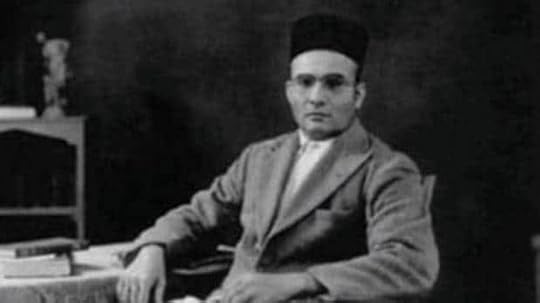 Savarkar
SavarkarA few years ago, the then Congress Vice President Rahul Gandhi proclaimed in Parliament that the difference between his party and that of the BJP was that one worshiped Savarkar while the other worshiped Mahatma Gandhi. One believed in violence while the other was the apostle of non violence. Since then, the Indian National Congress has fought(and lost) elections over this narrative. The fight, they say, is for the soul of India. The fight is for good against evil. Love against hate. Democracy against dictatorship. Secularism against Hindutva. The Congress walked right into the trap laid by the socially right Bharatiya Janata Party. This was an ideological warfare. The BJP set the narrative and the Congress accepted it.
This has been happening ever since the BJP came to power. Prime Minister Narendra Modi himself never gets tired of reminding the Congress about the faults of India’s first prime minister Jawaharlal Nehru. BJP MPs such as Sakshi Maharaj and Sadhvi Pragya go a step further by praising Gandhi’s assassin as a “patriot and nationalist”.
But are things so black and white? Do we really have to choose between Gandhi and Savarkar?
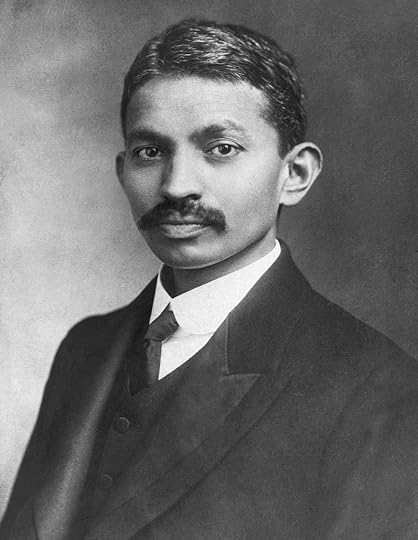 MK Gandhi
MK GandhiLets start with a story we’ve all heard before:- In 1893, a young lawyer named Mohandas Karamchand Gandhi was thrown off a first class compartment of a train after a white man refused to share a seat with him due to his skin color. He spent the night in the cold platform of Pietermaritzburg railway station. That was the day he resolved to fight against discrimination. “The hardship to which I was subjected was superficial”, writes Gandhi in his autobiography, “only a symptom of the deep disease of colour prejudice. I should try, if possible, to root out the disease and suffer hardships in the process. Redress for wrongs I should seek only to the extent that would be necessary for the removal of the colour prejudice.”
Gandhi’s fight wasn’t against colour prejudice initially. He was infuriated that Indians were treated in the same way as Kaffirs(racial slur){Volume 5, Collected works of Mahatma Gandhi}. He continued to repeat this well into late 1900s. The early Gandhi referred to whites of Transvaal as “white fellow colonists”.(Vol. 7). The Oxford historian Faisal Devji points out that Gandhi’s derogatory comments ceased when he was not practicing as a lawyer. However, Gandhi continued to use the word “Kaffir” 2 years after he stopped practicing law in 1910(Vol. 13). Let us assume for a moment that Gandhi’s rhetoric was merely an attempt to make compromise. He was, in other words, trying to change the system while remaining within the system. This still doesn’t justify a statement like this:-
We were then marched off to a prison intended for Kaffirs. There, our garments were stamped with the letter ‘N,’ which meant that we were being classed with the Natives. We were all prepared for hardships, but not quite for this experience. We could understand not being classed with the whites, but to be placed on the same level with the Natives seemed too much to put up with.(Vol. 8)
One cannot help but concede that in his early days, Gandhi was indeed a racist.
His views about the caste system weren’t really much different. Gandhi continues to be seen as one who actively fought to eradicate the caste system. Gandhi considered “untouchability” to be a curse. Yet, he continued to believe in an ambiguous form of caste system. Consider this statement, for instance:-
“The position that I really long for is that of the Bhangi. How sacred is this work of cleanliness! That work can be done only by a Brahmin or by a Bhangi. The Brahmin may do it in his wisdom, the Bhangi in ignorance.I respect, I adore both of them. If either of the two disappears from Hinduism, Hinduism itself would disappear. And it is because seva-dharma (self-service) is dear to my heart that the Bhangi is dear to me. I may even sit at my meals with a Bhangi by my side, but 1 do not ask you to align yourselves with them by inter-caste dinners and marriages.” (Navajivan,18 Jan 1925)
This aligns perfectly with traditional ideas of caste system. The implication is quite clear. By stating that both Bhangis and Brahmins are necessary for the existence of Hinduism, he is saying that there is no problem with the existence of these categories as such. Lest you have any doubt, Gandhi makes it clear below:-
The vast organization of caste answered not only to the religious wants of the community but it answered to its political needs. The villagers managed their internal affairs through the caste system and through it they dealt with any oppression from the ruling power or powers. It is not possible to deny the organizing ability of a nation that was capable of producing from the caste system its wonderful power of organization.(Vol. 15)
Gandhi considered Varnashram to be a “rational scientific fact” (his words, italics mine). He regarded Varnashram as a “healthy division of work based on birth”. In his view, it is possible for a Shudra to become a Vaisya or a Brahman. But there’s one problem. He can only become a Brahmin in his next incarnation. “A translartion from one varna to another in the present incarnation must result in a great deal of fraud” write Gandhi(Young India, 23–4–1925)
It comes as no surprise that when Dr. B.R. Ambedkar launched the Mahad Satyagraha to ensure that untouchables use water from public tank, Gandhi opposed it. Ambedkar writes:- The Untouchables were not without hope of getting the moral support of Mr Gandhi. Indeed they had very good ground for getting it. For the weapon of satyagraha — the essence of which is to melt the heart of the opponent by suffering — was the weapon which was forged by M r Gandhi, and who had led the Congress to practise it against the British Government for winning swaraj. Naturally the Untouchables expected full support from Mr Gandhi to their satyagraha against the Hindus the object of which was to establish their right to take water from public wells and to enter public Hindu temples. Mr Gandhi however did not give his support to the satyagraha. Not only did he not give his support, he condemned it in strong terms(What Congress and Gandhi Have Done to the Untouchables)
However, one of the leaders who did support it was Vinayak Damodar Savarkar.
Savarkar, unlike Gandhi, continues to be one of the most polarizing figures in Indian politics. He is responsible for popularizing the term “Hindutva”(which we’ll discuss in the next section). He considered caste system to be a “harmful vestige”. To him, scriptures were man made “which needed to be discarded as and when society evolves”. He writes:- “Thus, I reverentially bow my head to the vast, Himalayan corpus of Sanskrit literature of the Shrutis , Smritis , Puranas, Itihasas as they have shaped our Hindu mind over centuries. But I will not allow them to become fetters in my feet and retard my progress towards modernity, but instead draw inspiration from them to move ahead on modern, scientific terms.”(Savarkar Samagra, Vol 7. Translation by Vikram Sampath)
Savarkar actively advocated for disrupting the status quo. He cited the examples of Jesus, Buddha and Muhammad as social reformers who were mocked by their contemporaries for questioning the status quo. He writes “So, reformers who disturb the status quo, who become unpopular, who disturb the social equilibrium, who hurt religious sentiments, who turn their back on majority opinion, who think rationally have had to face the inevitable consequences of their actions”. (Ibid)
Ironically, Savarkar’s opinion on cow protection might startle the so called violent “gau rakshaks” of today. This is what he said about holy cows:- “Have horses and dogs not been man’s most trusted companions from time immemorial? A dog offers total and unconditional love to its master, aids man in his hunting expeditions, guards homes and is loyal till his last breath. Yet, we use the term ‘dog’ pejoratively for people we dislike! Why do we not worship a dog too and why be partial only towards a cow, only because she gives us milk? Is the utility of a dog or a horse any less, if that is the only yardstick for worshiping them? Horses, mules and donkeys have played such an important role in major battles against our nation’s worst enemies. Do we then begin a series of worship for these creatures as well, or would it suffice to assiduously undertake a protection mechanism for them?”(Ibid)
Savarkar’s views on science and modernity are far more relevant today than that of Gandhi’s. In fact, many of Gandhi’s beliefs were laughably superstitious. For example, Gandhi had blamed the Bihar Earthquake of 1934 as God’s punishment for the sin of untouchability. This led Rabindranath Tagore to call him out. Savarkar, on the other hand, thought scientific temper would lead to prosperity in India.
Savarkar is mostly remembered today for his philosophy of Hindutva. In 1923, he wrote his seminal pamphlet titled Hindutva:Who is a Hindu?
According to him, a “Hindu” is one who accepts India as his/her (i) motherland (ii) fatherland and (iii) holyland. This is, by definition, an exclusionary definition. Savarkar explicitly excludes “Mohammedans” and Christians. He writes:- “But can we, who here are concerned with investigating into facts as they are and not as they should be, recognise these Mohammedans as Hindus? Many a Mohammedan community in Kashmir and other parts of India as well as the Christians in South India observe our caste rules to such an extent as to marry within the pale of their castes alone; yet, it is clear that though their Hindu blood is thus almost unaffected by alien adulteration, yet they cannot be called Hindus in the sense in which that term is actually understood, because we Hindus are bound together not only by the tie of love we bear to a common fatherland and by the common blood which courses through our veins and keeps our hearts throbbing and our affections warm, but also by the tie of common homage we pay to our great civilisation — our Hindu culture, which could not be better rendered than by the word Sanskriti suggestive as it is of that language, Sanskrit, which has been the chosen means of expression and preservation of that culture, of all that was best and worth preserving in the history of our race.”
Muslims and Christians, by this definition, are potential traitors since their holylands are outside India. Their loyalties are to be doubted. They remain here only as guests. MS Golwalkar expanded this by stating that “foreign races”(by which he meant Muslims and Christians) don’t even deserve citizen rights. The only way for them to be included into the national fold is by accepting Hindu language and religion.
Savarkar further elaborated on Hindu nation(rashtra) in his book “Six glorious epochs of Indian history”. In it, he described religious tolerance practiced by a large majority of Hindus as a “suicidal creed”. He wonders why Hindus conferred legal rights on Muslims who “fell in their hands completely vanquished and utterly helpless” instead of massacring en masse the hundreds and thousands of Muslims(Yes, that’s a direct quote). He calls these Hindus “cow-faced”.
The worst is yet to come. He advocates rape as a weapon of war. He wonders why Shivaji and Chimaji Appa didn’t remember the rapes perpetrated by Muslim invaders while treating the Muslim women honorably. He considers this to be a result of “ suicidal Hindu idea of chivalry to women”.
He makes it more explicit through these lines:-
“If in the cattle-herds the number of oxen grows in excess of the cows, the herds do not grow numerically in a rapid manner. But on the other hand, the number of animals in the herds, with the excess of cows over the oxen, grows in mathematical progression. The same is true of man, for at the core man is essentially an animal. Even in the pre-historic times the so-called wild tribes of the forest-dwellers knew this law quite well. The African wild tribes of to-day kill only the males from amongst their enemies, whenever there are tribal wars, but not the females, who are eventually distributed by the victor tribes among themselves. To obtain from them future progeny to increase their numbers is considered by these tribes to be their sacred duty!”
I almost feel the urge to talk about why many of Gandhi’s ideas continue to be relevant today. However, I assume the reader has already been exposed to it enough. Gandhi’s method of non violent resistance served as an inspiration to many in the world, including Martin Luther King Jr. and Nelson Mandela. The reason most of us aren’t aware of his faults is because he has been elevated to the status of a saint. A hero. An idol. Almost Godlike. Thus, the only ones who criticize him are either those who hate him due to ideological possession or those who take time to actually study him. History is not black and white.
In his satire on Indian Freedom struggle “The Great Indian novel”, Dr. Shashi Tharoor wrote “This story, like that of our country, is a story of betrayed expectations, yours as much as our characters. There is no story and too many stories, there are no heroes and too many heroes. What is left out matters almost as much as what is said.”
We tend to see history as a consequence of significant actions and revolutions of great men. We assume, for instance, that Gandhi was almost solely responsible for giving us freedom. That World War 2 happened due to Hitler. And so on. Thomas Carlyle called this the “Great man theory”. Leo Tolstoy, in War and Peace, argued that this is merely an illusion. That significant changes in history wouldn’t have been possible without small actions of multitudes of individuals whose names are not inscribed in gold. Yet, all of us fall prey to the “Great man theory”. All of us create a binary when there is none.
Savarkar or Gandhi? The truth is that these were flawed individuals. The individuals who led us to freedom. The individuals who wrote our constitution weren’t perfect. They were products of their own time and circumstances. These weren’t the perfect idols we consider them to be. They contradicted themselves. One can recognize their flaws and still appreciate their contributions. It is time for political parties to stop their ahistorical one sided narrative and concentrate instead on things that matter:- the economy, eradication of disease, poverty and the well being of all.

April 9, 2020
The Conservative Lie of Cultural Marxism
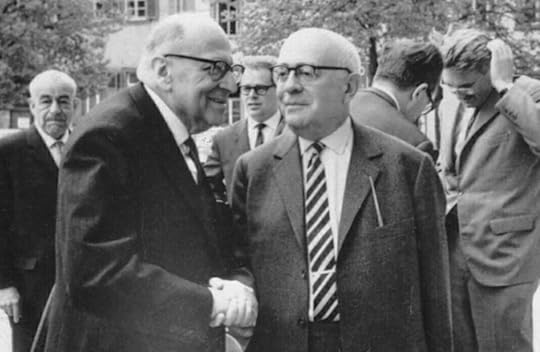
It all starts with Marx. Or so they’ll have you think.
Popular conservative/libertarian YouTube channels and blogs never get tired of using the term “cultural Marxists”. The term experienced a revival in the internet when the Norwegian far-right terrorist Anders Breivik responsible for the death of 77 innocent human beings denounced it in his manifesto. Breivik claimed that “Islamisation of Europe” cannot be stopped until “political doctrine of cultural Marxism” is removed. What, exactly, is cultural Marxism? According to Brievik, it is “ Marxism translated from economic into cultural terms.” A group of intellectuals helped to make this transition through a school of social and critical theory now known as the Frankfurt school. Followers of this school now include “journalists, editors, teachers, lecturers, university professors, various school/university board members, publicists, radio commentators, writers of fiction, cartoonists, and artists/celebrities etc.” In Brievik’s fascist utopia, these “traitors” deserve nothing less than the death penalty.
The originAccording to the paleoconservative thinker William S. Lind, the world has now entered the stage of “fourth generation warfare”. Unlike the first three generations of warfare, the fourth generation is characterized by the state losing “its monopoly on war”. It is, instead, the citizens who directly engage in battle. The fourth generation war is not merely fought between geographical territories. It is fought between cultures. The conflict between Al Qaeda and the US is seen as a conflict between the Christian West and Islam. Lind goes on to claim that “invasion by immigration is as dangerous as invasion by a state army”.(Lind, 2004)
This idea serves as a precursor to the modern version of Cultural Marxism(popularized by Lind himself). The common right wing narrative goes as follows:- The failure of the natural progression of communism from capitalism’s internal contradictions frustrated the original Marxists. A few European intellectuals sought to change the classic doctrine. Thus, the focus moved from “class” to “culture”. These(mostly Jewish) intellectuals decided to indoctrinate and mobilize the masses by infiltrating “culture” to destroy western civilization in order to usher in the communist utopia. They belonged to the Institute of Social Research at Goethe University, Frankfurt and thus came to be collectively known as the “Frankfurt School”. These *dangerous, totalitarian and parasitic* ideas eventually infected the world and college campuses. As the late conservative commentator Andrew Breitbart pointed out “We experience it on day to day basis. It’s political correctness and multiculturalism”.
We’re getting a bit ahead of the story. Let’s go back to the good old days of the 18th century. The early 20th century fabricated anti-semitic propaganda piece called The Protocols of Elders of Zion sought to expose the Jewish plan to dominate the world. This document helped the Nazis to link anti-semitism with communism. In Mein Kampf, Adolf Hitler claimed that Bolshevism was a Jewish effort to take “world domination unto itself”. Surprisingly, in Nazi propaganda “Marxism” was referred to as the “guardian angel of capitalism”. “Cultural Bolshevism” was used as a derogatory term to dismiss modern “decadent” art which were seen as a threat to German traditionalism.
The Frankfurt school emerged during the time Nazism was on rise in Germany. The intellectuals associated with it include Theodor Adorno, Herbert Marcuse, Jurgen Habermas, Leo Lowenthal, Erich Fromm, Georg Luckacs etc.
To show the parallel between cultural Marxism and classical Marxism, Lind points out five crucial similarities. We’ll tackle with each of these one by one.
Both are totalitarian ideologies:- Aspects of Marxism are certainly totalitarian in nature as witnessed by communist dictatorships. The same cannot be said of the so called *Cultural Marxists*. In fact, Herbert Marcuse wrote a book length critique of Soviet Marxism. This received praise from the anti-communist Catholic Priest John Francis Cronin. To demonstrate that Cultural Marxism is totalitarian, Lind cites PC culture around college campuses. Needless to say, this is an insult to the victims of Stalinist Russia.Single factor view of history:- The idea here is that cultural Marxists create an “us” vs. “them” narrative. This is partially correct. Critical theory is indeed often dichotomous. However, not in the sense Lind and his accomplices would have you believe. Drawing on Lind’s term, the conservative author Pat Buchanan writes “ the cultural Marxist repeats and repeats the charge that the West is guilty of genocidal crimes against every civilization and culture it has encountered.” Buchanan provides no credible evidence to support this. Instead, he goes on a tirade against popular culture stating that “ films and shows that depict women as tough and aggressive and men as sensitive and vulnerable testify to the success of the Frankfurt School and the feminist revolution it helped to midwife”. This is apparently a bad thing for him. I have nothing more to add.Both declare certain groups virtuous and others evil a priori:- Classical Marxists consider workers to be virtuous and the owners of the capital to be evil while cultural Marxists consider white men to be evil and blacks, feminists, Hispanics, homosexuals etc. to be “good”. This is directed specifically at modern critical theorists. Lind would be surprised to know that one of the most influential contemporary critical theorists Nancy Fraser is actually a prominent critic of identity politics. Fraser has argued that the reification of group identities “encourages separatism, intolerance and chauvin-ism, patriarchalism and authoritarianism.”Expropriation :- Affirmative action is cited as an example of how cultural Marxists discriminate against white men and give privileges to the groups they favor. Who are the cultural Marxists? Does it include both the Republican and Democratic establishment? Does it include an individual who supports capitalism as well as affirmative action? About half of Republicans support Affirmative action. Are they cultural Marxist?Both employ a method of analysis designed to show the correctness of their ideology in every situation:- Both think they’re correct. But so does every other political ideologue. So does every religion.How can one defeat political correctness(the defining ideology of cultural Marxists)? Lind has an answer. We can defeat this menace by stating truths “such as the facts that violent crime is disproportionately committed by blacks and that most cases of AIDS are voluntary”. One can defy it by following old rules of Culture. “Ladies should be wives and homemakers, not cops or soldiers, and men should still hold doors open for ladies. Children should not be born out of wedlock. Open homosexuals should be shunned” writes Lind.
Urban Naxal:- The Indian version of *Cultural Marxism*
In 2018, the Indian film director Vivek Agnihotri published a book titled *Urban Naxal*. He claimed that intellectuals, journalists, professors and celebrities indoctrinate vulnerable sections of the society with the pernicious ideology of Naxalism through subtle brainwashing. He writes:-
“If police and other sources are to be believed, the Naxalites, with the help of Dalit youths and the Islamist terrorist group Indian Mujahedeen (IM), want to have their own government in the country by 2025. The revolution will emerge from the conflict of Hindus on one side and Dalits and Muslims on another. Two consolidated rebellious, energetic forces pumped with raw adrenaline, will go for each other’s blood. And then it will be opportune to hijack and change the narrative to oppressed, proletariat, and marginalized vs bourgeoisie, elites, and Brahmins. This attracts poor and intellectuals both. In this case, the Adivasi, Dalits, Muslims, and other “forgotten people”, united under one common red flag, will demolish the State. That’s the ambition. And they also have a plan.”
Mr. Agnihotri provides no citation for this whatsoever. He doesn’t seem to have made the slightest effort to understand the ideology he’s criticizing. He claims that the then President of Congress Sonia Gandhi nurtured Naxal sympathizers through policy agencies with no evidence to back it up.
According to Agnihotri, these “Urban Naxals” don’t just disseminate propaganda. They also recruit people. The only difference between “Cultural Marxists” and “Urban Naxals” is that while cultural marxists are hellbent on destroying Western civilization, urban naxals are hellbent on destroying Hindu civilization.
The term has gained popularity among Indian Right Wing circles. It is now used to label everyone who is critical of the present ruling regime. Mr. Agnihotri himself has diluted its meaning in his book as well as tweets. For instance, he has called the historian Ramachandra Guha “an urban naxal”. Dr. Guha has been consistently anti-communist. He has written many pieces over the years, often calling it “outdated” and criticizing suppression of religion in communist regimes. To claim that Dr. Guha supports Naxals, one needs to provide at least some amount of credible evidence.
Frankfurt School and the Culture IndustryKarl Marx believed in economic determinism. Thus, the determining factor for him in analyzing history was class struggle. Orthodox Marxists continue to believe that class is the only real social division. Some Marxists also consider culture to be a part of Marxism itself. Therefore, the idea of applying Marxism to “superstructure” can only be termed as an oxymoron. The conservative economist Gary North rightly points this out. He argues that “the idea of transforming the West through cultural revolution” is a Hegelian argument, not a Marxist one. So, no, it doesn’t start with Marx.
The Frankfurt school was inspired by the ideas of Hegel, Marx, Kant, Weber and Freud. They believed that power has an overarching influence over the ideas and norms that society values. This presents us with a distorting picture of reality and helps to preserve the status quo. The way to get around it is to look at power critically. It is this which can lead us to an accurate approximation of the truth.
This is evident in the way mass media functions. Noam Chomsky’s Manufacturing Consent(which I highly recommend) rightly points out how mass media serves the interest of big corporations as well as nations.
We’re living in the age of late capitalism. Our lives are becoming monotonous and repetitive. The consumerist attitude has invaded culture. As a result, we are fed the same products, the same movies, the same music and the same art with only minor variations. Adorno and Horkheimer term this “the Culture industry”. In dialectic of Enlightenment, they write “Culture today is infecting everything with sameness. Film, radio, and magazines form a system. Each branch of culture is unanimous within itself and all are unanimous together.”
We are veering steadily towards a consumerist world portrayed in Bret Easton Ellis’ American Psycho. Think about how similar Adorno and Horkheimer’s argument is to that of the conservative philosopher Roger Scruton. In his documentary on the value of beauty, Scruton says “Our consumer society puts usefulness first, and beauty is no better than a side effect.” This critique of culture is more relevant now than ever. Perhaps the best example of the “culture industry” is the popularity of big budget Marvel movies. All of these movies are characterized by roughly the same settings, the same characters and the same action scenes with little variation. These variation provide us only with an illusion of difference. Studios are not ready to take risk. Good original and innovative movies with emotional/spiritual/sentimental values often don’t even make it to theaters. The same goes for music. All pop music sound the same. The advent of electronic music(Bilie Eilish, anyone?) has led to a decline in melody. Instead, we are subjected to listen to bare whispers under mechanical monotonous beats. As Scruton wrote “The music is generated from a point outside, assembled from a repertoire of effects, according to procedures which involve little or no invention, but which set the music into a machine-like motion with repetition as the principal device”. Long gone are the days of experimentation. Long gone are the days when Dylan and Simon&Garfunkel wrote lyrics as elegant as poetry. This is why the Frankfurt School’s critique matters even today. In fact, as we have seen, their critique of popular culture is strikingly similar to the critique of conservative philosophers as well as popular conservative YouTube vloggers like Paul Joseph Watson. It is time for the right to give up its irrational, ignorant and often bigoted hatred of the Frankfurt School. Once they remove this *veil of ignorance*, they’ll find that the so called Cultural Marxists have more in common with them than they assumed.

March 26, 2020
Solitude in the age of Corona

The Corona-virus pandemic has forced the world to virtually shut down. It has also forced the most extroverted of us to stay at home, away from the eyes of the world and of friends. What extroverts are feeling right now is not strange to the likes of me. The sense of suffocation is ever present in the functioning normal world for introverts.
Solitude is not the feeling of suffocation. Solitude is not merely the state of being alone. No one understood it better than Henry David Thoreau. He saw solitude as a “companion”. This is what led him to live alone near Walden pond. He was “alone” only in the conventional sense of the word. He was separated from members of his own species and the daily monotonous state of life. However, he was surrounded by the wild free venison, the rabbits and patridges, the snow covered plains,blossoms of fruits and the unexplored woods. Why did he went to the woods? I’ll let Thoreau speak for himself:-
“I went to the woods because I wished to live deliberately, to front only the essential facts of life, and see if I could not learn what it had to teach, and not, when I came to die, discover that I had not lived. I did not wish to live what was not life, living is so dear; nor did I wish to practise resignation, unless it was quite necessary. I wanted to live deep and suck out all the marrow of life, to live so sturdily and Spartan-like as to put to rout all that was not life, to cut a broad swath and shave close, to drive life into a corner, and reduce it to its lowest terms, and, if it proved to be mean, why then to get the whole and genuine meanness of it, and publish its meanness to the world; or if it were sublime, to know it by experience, and be able to give a true account of it in my next excursion.”
 Walden
WaldenI feel content every time I read those lines. An individual who’s scared of solitude might find Thoreau’s endeavor to be rather futile. But isn’t beauty the ultimate goal that humans strive for?
 Keats
KeatsBefore Thoreau, the romantic poet John Keats too treated Solitude as a person. As a friend. The idea of experiencing solitude “among the jumbled heaps of murky buildings” terrified him. Instead, he wanted to experience solitude in “Nature’s observatory”. Keats, unfortunately, never got a chance to experience it as intensely as Thoreau. He lived a lonely life. His attempt to make peace with solitude almost seemed forced(evident through the first lines of the poem “O Solitude!”).
Some readers might find Keats and Thoreau’s views to be too romanticized. Friedrich Nietzsche would agree. We are surrounded by people who tell us what to do, what to think , what to feel, what to believe and what to speak. Most of us sincerely believe that these people care about us. They want the best for us. Thus, the idea of questioning the existing norms eludes us entirely. Sometimes, we recognize the harm and suffering that these norms cause us. We seek to find another group instead with better norms and values. This pursuit, to me, is not the way out.
“He who seeks may easily get lost himself. It is a crime to go apart and be alone’ — thus speaks the herd” — Friedrich Nietzsche
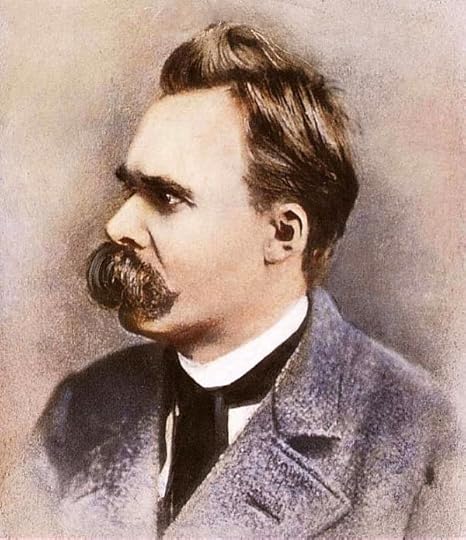 Nietzsche
NietzscheFor Nietzsche, this was herd mentality. The way out of this is to separate yourself from the herd. It is the lonely philosopher who “offers a refuge from the tyranny” of the establishment(government,religions&public norms) by opening up the “inner sanctuary or the center of heart’s labyrinthe”(Nietzsche, 1874)
When we separate ourselves from the herd, we start a process of self introspection and find things which truly matter to us. Some of us might find things that shake us to the core. Perhaps this subconscious fear is why most of us don’t dare to question the herd. For instance, many of us might find that the job that we do is the reason for our feelings of hopelessness. The acceptance of this might eventually lead to decisions which, at least temporarily, would destabilize us. However, this will prove to be more fulfilling for us in the long term.
Solitude also enhances creative thinking. It allows the mind to reflect and form original ideas. Great artists like Vincent Van Gogh, Dylan and Dostoevsky have managed to successfully capitalize on their solitude. The lack of societal constraints allows artists to expand the boundaries of their thinking.
All of this is not to say that there is no danger at all in Solitude. For some, solitude might be too chaotic. It might lead to the growth of the “beast within”. Thus, Nietzsche wrote “many should be dissuaded from solitude”. To avoid this, we must want solitude. It must not be forced upon us. Loneliness is forced but solitude is voluntary.

The image of Sisyphus rolling the boulder comes to my mind again. The idea seems futile to him initially. But he realizes that the pursuit of other goals is unfeasible. The only goal he can pursue is the rolling of the boulder. There comes a moment when Sisyphus enjoys the seemingly futile task. He wants to roll the boulder now. And that’s when he smiles.
We must all be like Sisyphus now. We must all voluntarily choose to enjoy solitude.

February 14, 2020
“Be Great and Make your Country Great”:- An Obituary for my grandfather
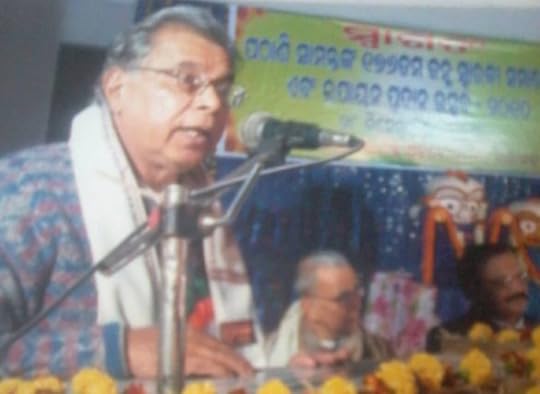
I have always been afraid of writing an obituary. The thought itself is rather revolting. It is easy to write about a character’s death in a novel or a play. It must have been easy for Ernest Hemingway(A Farewell to Arms) and John Steinbeck(Of Mice and Men) to end their story on a sentimental note. But it’s not easy for us readers/viewers. We become accustomed to those characters and their loss seems personal. But not as personal as the loss of someone you’ve known since childhood. Or perhaps a friend. It is easy to write about death from one’s own perspective. You’ll just stop existing and it wouldn’t matter to you, would it?
It would matter only to those whose lives you’ve touched.
There is nothing to write of my first encounter with him. He was my maternal grandfather and therefore, I had always known him. Almost half my childhood was spent in his beloved town of Nayagarh. It is a relatively small town concealed from most of us. Surrounded by hills, the town has remained constant. It wasn’t his original home. He had adapted this place and made it his own.
His father had died before he was even born. He spent his childhood in squalid poverty. His elder brother,who worked as a peon, ensured that he went to school. Until then he was called “Bhalu”(Odia for “Bear”), a name he acquired as a consequence of his long hair. His teacher enrolled him in the school as “Dukhishyam”(“Dukhi” meaning sad and “shyam”being a name of Lord Krishna).
His surname juggled between “Patra” and “Mohapatra”(owing to his informal adoption by different families). He started doing petty jobs and earning money at the age of 8–9 due to his family’s penury. That was when a station master named Damodar Das decided to help him study. He would wash utensils, cook and do other domestic works while managing his school work. He decided to settle on the surname “Das” as a tribute to his guardian. While this might seem trivial to us, in the rural Indian caste-obsessed psyche it must’ve been seen as a heresy.
With considerable hard work, he managed to graduate from the English Department of Utkal University in the late in 1960s. He fell in love with the town of Nayagarh, where he worked as a senior lecturer in English.
He would wake up at dawn and listen to the radio. His early rituals included feeding the crows at the terrace. They would gather around him as he would smilingly throw crumbles of chapatis/bread to them. I can vividly remember witnessing this. He was quite attached to animals. His heart would go out for stray cows,bulls and dogs. Often, he would help in organizing feasts for cows,bulls, dogs as well as human beings. He ensured that many injured and sick animals got the proper veterinary care that they needed.
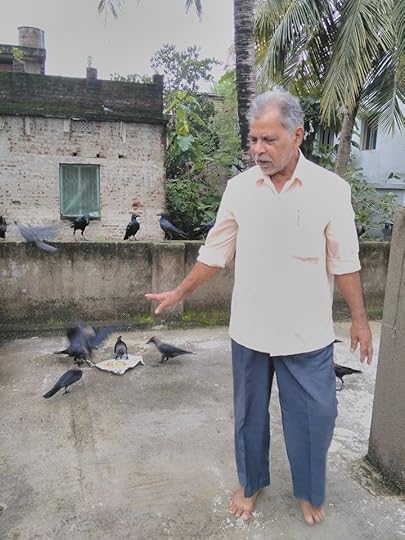 Feeding the crows
Feeding the crowsThis was merely one aspect of his multi-faceted personality. He was known for his hearty laugh. During his student years, he was often punished for laughing noisily. But as he grew older, this laugh ensured that people connected with him as soon as they met him. He would become happy at other’s success. He would greet you with “Jai Shree Ram”. He would treat you as if you are a member of his family. He would hug you when he meets you again. And as you plan to leave, he would bless you and tell you “Be Great and Make your country great”.
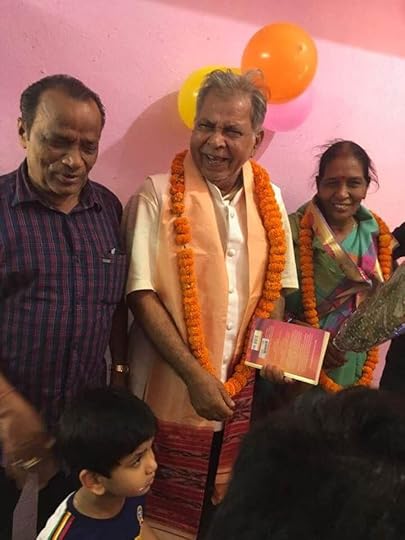 With Grandfather, grandmother and his grandson
With Grandfather, grandmother and his grandsonThis was the refrain of his life. And how mellifluous those words are! If you do something great for others, you do something great for your country. And if your country benefits from your work, the whole world benefits.
His social work was covered in numerous regional newspapers. One of these newspaper articles termed him as “Gacha manisha”(The Tree Man). He had planted hundreds of trees. He treated them like his own off-springs. He also organized feasts celebrating the marriage of banyan trees with peepal trees(a local custom). For him, ritual was just an excuse to raise awareness and celebrate the beauty of nature. He would distribute pamphlets to people at these events containing stories about the importance of trees.
Enter CancerCancer. Or “The Emperor of All Maladies” in the words of Pulitzer Prize winning Oncologist Dr. Siddhartha Mukherjee. The problem with Cancer is that it’s almost wired in us. It isn’t caused by a micro-organism that you can eradicate or weaken. It is the unfortunate and abnormal growth of cells. Mukherjee considers Cancer cells to be “inventive copies of ourselves”. It is as if they harbor colonialist tendencies. They expand from one territory to the other. They are intransigent in their malevolence. “To confront Cancer” writes Mukherjee, “ is to encounter a parallel species, one perhaps more adapted to survival than even we are.”
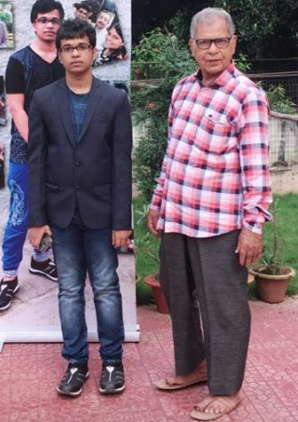 Me with him
Me with himHe was diagnosed with Stomach Cancer(last stage) just a month ago. When he came to Bhubaneswar for treatment, I didn’t notice any change. I knew he was ill. I didn’t know it was Cancer until much later. My last conversation with him was at the hospital. There wasn’t much change in his physical appearance then except that he appeared a bit pale and thin. He was fighting a monster. A monster that was to consume him in less than a month. I was surprised at the diagnosis considering that his diet was as simple as it gets. Boiled vegetables, fruits, chapattis, rice, milk, fish and eggs. It wasn’t out of compulsion. He just didn’t like anything else. He was a non smoker and a teetotaler.
My dad would visit him at the hospital everyday and talk with him. He recorded many of these conversation. Even during those last moments, his mind was preoccupied with thoughts about literature, music, culture and his love for the Odia language and the country.
He observed the drops of blood falling in the saline container. It reminded him of Margaret Cole’s poem “The Falling Leaf”:-
They fell, like snowflakes wiping out the noon;
And wandered slowly thence
For thinking of a gallant multitude
Which now all withering lay,
Slain by no wind of age or pestilence,
But in their beauty strewed
Like snowflakes falling on the Flemish clay.
This Republic Day(some 20 days ago), he asked my father if there was any flag hoisting nearby. He was too weak to walk then. Dad took him down on a wheel-chair. He saluted the flag and smiled(photo below). He started talking to the people gathered there. He told them that hoisting the flag on special occasions isn’t enough. If one wants to pay tribute to our country then one must work for it. He asked them all to plant a tree as a tribute to their motherland.

There were numerous condolence meetings organized in his beloved town. I was rather pleasantly surprised to hear anecdotes from his students and acolytes. One of these students recounted that he was once selected for a debate competition. He didn’t have enough money to travel outside the town and the college had no provision to provide money. My grandfather paid the required amount without any hesitation.
He wasn’t able to talk in his last 5 days. When I went to meet him at the hospital some 3 days before his death, he stretched out one of his hands, which I held for a while. He listened when we called him. He nodded and opened his eyes. But he couldn’t speak. I was told that he responded to a greeting with “Jai Shree Ram” a day before his death. Those were possibly his last words.
In the Oscar winning Disney movie Coco, the protagonist Miguel travels to the land of the dead. This beautiful and enchanting dream like place is inhabited by those who’ve died on Earth. However, even in the land of the dead, there is a *second death*. The dead people vanish into nothingness when they are forgotten by everyone in the land of the living. This is a beautiful metaphor. An individual never dies as long as he’s remembered.
My grandfather will be remembered and missed. He will be remembered by the thousands whose lives he has touched. He will be remembered by the hundreds of trees he has raised. And he will be remembered by his family. Most importantly, he will be remembered through the written word, which never fades away. And thus, he will always stay alive.
This is for him. For my mom, who’s stronger than I could ever hope to be. For my dad, who has always been there. For my grandmother. And for my two uncles.
And for you, dear reader, let us pledge to “be great and make our country great”.

January 13, 2020
We,the people:- CAA and an interval of democracy

The events of the last few weeks have been tumultuous for India. The passing of the Citizenship Amendment Act marks a significant departure from the ruling regime’s previous way of functioning. It is true that BJP has made its intentions clear on contentious issues like Article 370 and the Ram Temple. However, for over half a century these issues were only used as agitprop. All of that changed when BJP was re-elected in 2019.
Narendra Modi’s regime is not inefficient. By not doing anything, an inefficient government will inevitably and unintentionally become a strong defender of the status quo. Modi’s regime is highly efficient and it is this efficiency that unnerves people. No, that’s not a defense of Mr. Modi. Let me frame it this way:- In Ram Guha’s words, Mr. Modi’s government is “malevolently” efficient. Nobody claims that Jack the Ripper,a serial killer who terrorized the city of London in 1880s, was an altruistic individual. But it can be argued that he was a successful criminal since he evaded arrest(For those with comprehension issues, let me explicitly state that there’s a difference between an analogy and a comparison).
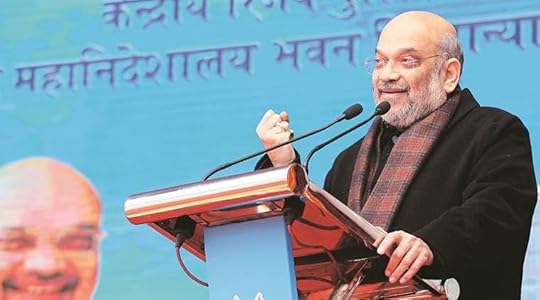
In April 2019, the then BJP chief Amit Shah referred to illegal migrants from Bangladesh as “termites”. After coming to power, he explicitly stated that Rohingya refugees will not get citizenship in India. Mr. Shah, the home minister of the country, is more lenient towards Hindu, Buddhists, Sikh, Jain and Christian refugees. The Citizenship Amendment Act promises citizenship to refugees belonging to these religions who have fled to India before December 2014 after facing persecution in Pakistan,Bangladesh and Afghanistan. As a liberal, I welcome all attempts to help refugees. As a pragmatist, it is hard for me to ignore the cognitive dissonance in Mr. Shah’s positions.
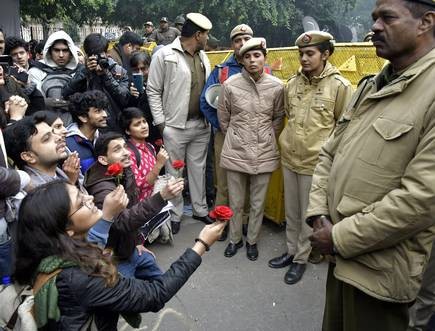
I’d have been absolutely fine with this if the govt would’ve promised citizenship to the Tamils from Sri Lanka and the Rohingyas from Myanmar as well. Mr. Shah never fails to mention the sin of partition while defending this bill. The argument being that it is the moral duty of the Indian state to protect the minorities of Pakistan since Indian politicians agreed to divide the country in 1947 on religious basis. Why include Afghanistan, then? Besides, the home minister has simply got his facts wrong in this case. While defending the bill in the Parliament, he stated that the population of minorities in Pakistan declined from 23% in 1947 to 3.7% in 2011. Referring to Bangladesh, he stated that the population declined from 22% to 7.8% in 2011. I wasn’t able to find any reliable official report for this statistic. According to the first census of Pakistan(1951), non-Muslims comprised 3.44% of overall population in West Pakistan and 23.2% in East Pakistan(Bangladesh). The figure has fairly remained constant, with a slight decrease in 1961. The latest available stats on religious data are from 1998, in which non-Muslims form 3.7% of Pakistan’s population. As far as Bangladesh is concerned, there has been a significant decline in the population of Hindus(from roughly 22% in 1951 to 8.3% in 2011). Yes, minorities have faced severe persecution in Pakistan. However, Mr. Shah needs to do a little bit of homework. It’s his words against facts :)
The aftermath of CAA has been catastrophic for this government. People from across the country came to protest. It was as if “the soul of a nation, long suppressed found utterance”(To use Nehru’s words). Students are still protesting. Perhaps, this tide won’t stop until those in power listen. I support the right of the students to protest. Nevertheless, I disagree with many of the rhetoric being used.

Some of the slogans used in the protest carry explicit Islamic connotations(kalma). There are also various reports about extremist slogans(some of whom are unreliable). Dr. Shashi Tharoor spoke for many of us when he tweeted “Our fight against Hindutva Extremism should give no comfort to Islamist extremism either”. Slogans that have explicit religious connotations alienate those of other faiths. A common objection raised to this argument is that since the law excludes Muslims specifically, it is fine for them to seek comfort in their own identity. There are two problems with this argument. First, the protesters claim to be protesting for a secular India. If their aim is to bring everyone together, they must discard religious rhetoric lest they harm the movement itself. Second, the law doesn’t merely exclude Muslims. It also excludes atheists and apostates, who have been systematically oppressed by the Pakistani state. For instance, the irreligious blogger Ayaz Nizami is still in jail and could be given the death penalty.
In conclusion, it’d be hard for Mr. Modi to recover from the anger of the masses. The people understand and see through the polarization. The establishment would like you to believe that the protests are merely a conspiracy by the opposition. They are wrong. The protesters are citizens of this nation. Their demand must be heard. The establishment is under the calamitous delusion of grandeur that they have the power. The power resides with the masses. This might just be the Anna Hazare moment for this regime. These protests might be the beginning of the end for Narendra Modi.

October 1, 2019
A 16 year old’s contrarian take on Greta Thunberg and the Climate Crisis
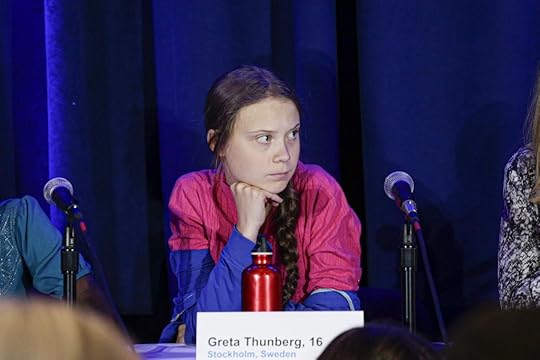
In the 1980s, 10 year old Samantha Smith wrote a letter to the then leader of the Soviet Union Yuri Andropov pleading him to avoid war. The letter was published in the official Soviet paper Pravda. A year later, she received a response and flew over to USSR. The Soviet media followed her every step and turned her into a house-hold name. The fact that she was used as a propaganda tool was more than obvious.
In 2015, a 5 year old girl named Sophie Cruz broke through security to deliver a message to Pope Francis. She was reportedly “scared that the ICE will take her parents away”. Her trip was sponsored by immigration advocacy group La Hermandad Mexicana Transnacional.
The vulnerability, innocence and naivety of children makes them a convenient tool for political activism. The same, however, cannot be said for someone of my age.
Unlike Samantha Smith and Sophie Cruz, Greta Thunberg knows what she’s doing. She has the intellectual capacity to articulate and defend herself. She is now arguably the most influential climate change activist in the world. The fact that a fellow 16 year old’s opinion is being heard globally makes me feel good about the future. Yet, the certitude and unquestioning manner with which adults believe in her claims is perplexing to me.
According to a report published in “The Times”, Greta Thunberg was discovered by the social entrepreneur Ingmar Rentzhog. Rentzhog was trained by Al Gore’s environmental group “The Climate Reality Project”. In his e-mails to “The Times”, Rentzhog repeatedly changed his story about how he met Greta. Upon further investigation, the report found that Greta was one of the winners of the environmental writing competition run by the Swedish newspaper Svenska Dagbladet. She, along with the other winners, was invited by climate activist Bo Thoren to participate in a school strike. However, since no one was interested, Greta did it herself. This was planned by Rentzhog, who knew about Greta 3–4 months before the incident. The rest, as they say, is fame¹
A critical evaluation of Greta Thunberg would reveal that her statements are often catastrophic exaggerations and factually incorrect.
Thunberg claims that world leaders have “stolen her dream and childhood” while emphasizing that people are dying and suffering. The fact is that less and less people are dying today than in any other time in history. According to the World Bank, 1.1 billion fewer people live in extreme poverty today than in 1990² There has never been a better time to be alive.
Her concerns about climate change are real. Earth’s average temperature has increased by about 0.8 °C since the industrial revolution rapidly. There is a broad scientific consensus about Anthropogenic climate change being real problem that needs to be dealt with. However, her understanding of the issue is only partially accurate and her solutions are Utopian. She claims that the consequences will be much worse than predicted due to “feedback lops and tipping points”.
This is only partially correct. The debate over whether global warming is linear with progressively worsening effects is not yet resolved. We have witnessed multiple abrupt climate change events, most notably the Younger Dryas. These events have been rare and few.
Greta has repeatedly expressed her disdain for “fairy tales of economic growth”. It is, quite simply, not possible for countries to fight climate change without economic growth. The Paris Climate treaty, for instance, is possibly the most expensive treaty in history. Yet, according to UN reports, 2C target can only be reached if nations triple their efforts³ She traveled in a Zero emission boat to take part in the UN summit. Though she is privileged enough to afford it, the fact remains that the majority of the world can’t even afford electric cars. The International Energy Association finds that even an increase of electric cars to 130 million in 11 years would result in the reduction of only 0.4% global emissions⁴. Poor countries cannot fight climate change. South Africa, a relatively rich country, plans to build eight nuclear power station to reduce the country’s reliance on coal. The estimated cost is one trillion South African Rands! Economic growth is not complementary to fight climate change. It is necessary.
Perhaps the most outrageous assertion of hers is the claim that world leaders are looking away and that “solutions are nowhere in sight”. This is not true. We have saved many species from extinctions. One example of it are the humpback whales, who were listed as vulnerable in 1996. In 2008, their status was changed to “Least concern”. Their population is now over 80,000. Environmental Progress can be tracked through the Environment Performance Index. Out of the total 180 countries being tracked over a decade, 178 have shown improvement. EPI also reveals that the wealthier countries are the cleanliest. Harvard University’s Steven Pinker writes “poor countries have gotten richer in recent decades…..the proportion of the world’s population that drinks tainted water has fallen by five-eighths, the proportion breathing cooking smoke by a third. As Indira Gandhi said, “Poverty is the greatest polluter.”
Enough is enough. It is time for us to start talking about pragmatic solutions. We can only find common ground when we engage in nuanced, respectful and decent disagreements. The assumption that Greta Thunberg’s claims shouldn’t be subjected to the same amount of scrutiny as that of a normal adult is erroneous, condescending and an insult to her very being. It is time that we listen to facts not hyperbole. I care about climate change and that is why I think we can’t afford to not have a debate on its solutions.
1- https://www.thetimes.co.uk/article/greta-thunberg-and-the-plot-to-forge-a-climate-warrior-9blhz9mjv
2- https://www.worldbank.org/en/topic/poverty/overview




